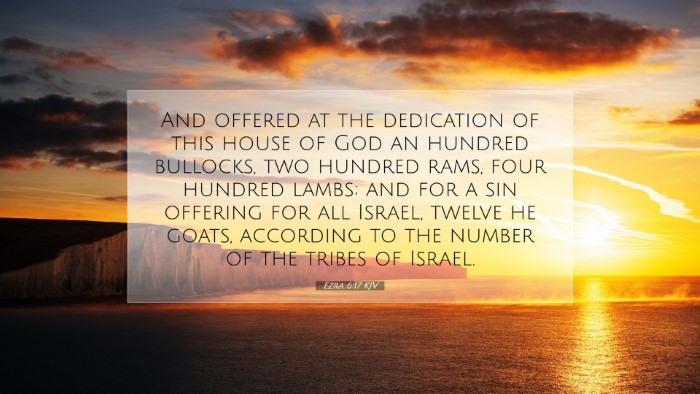Old Testament
Genesis Exodus Leviticus Numbers Deuteronomy Joshua Judges Ruth 1 Samuel 2 Samuel 1 Kings 2 Kings 1 Chronicles 2 Chronicles Ezra Nehemiah Esther Job Psalms Proverbs Ecclesiastes Song of Solomon Isaiah Jeremiah Lamentations Ezekiel Daniel Hosea Joel Amos Obadiah Jonah Micah Nahum Habakkuk Zephaniah Haggai Zechariah MalachiEzra 6:17
Ezra 6:17 KJV
And offered at the dedication of this house of God an hundred bullocks, two hundred rams, four hundred lambs; and for a sin offering for all Israel, twelve he goats, according to the number of the tribes of Israel.
Ezra 6:17 Bible Commentary
Commentary on Ezra 6:17
Ezra 6:17 states:
"And offered at the dedication of this house of God an hundred bullocks, two hundred rams, four hundred lambs; and for a sin offering for all Israel twelve he goats, according to the number of the tribes of Israel."
Introduction
The verse marks a significant moment in the history of the Jewish people, illustrating their gratitude and religious dedication following the completion of the Second Temple. The offerings mentioned serve not only as a fulfillment of ritual law but also as a communal expression of unity and repentance.
Significance of the Offerings
The offerings outlined in this passage are rich in symbolic meaning and serve various purposes within the context of Israel's relationship with God. The choice of animals is notable:
- Bullocks (100): Represent strength and are often associated with significant sacrifices, indicating the seriousness of the occasion.
- Rams (200): Known for their prominence in sacrificial events, they symbolize leadership and serve as a replacement for the firstborn.
- Lambs (400): Often linked with innocence and meekness; their sacrifice points to the themes of redemption and grace.
- He Goats (12): Representing the tribes of Israel, these goats are a significant acknowledgment of national sin and the need for corporate atonement.
Theological Reflections
From a theological perspective, several insights can be drawn from the offerings described in this passage:
- Covenantal Remembrance: Matthew Henry reflects on the idea of sacrifices as a means to recall God's covenant with His people. The large number of offerings underscores Israel's recognition of their dependence on God's mercy.
- Symbolism of Dedication: Albert Barnes notes that the extensive offerings demonstrate the people's commitment to dedicate the newly built temple to God. It represents a new beginning following their return from exile, reaffirming their identity as God’s chosen people.
- Repentance and Restoration: Adam Clarke highlights the twelve he goats as a sign of repentance. This act acknowledges the need for atonement for the sins of the nation and restores the relationship between God and His people.
Liturgy and Community
The communal aspect of these sacrifices cannot be overlooked. This moment signifies a collective return to worship, as it was essential for the people to reunite around this sacred act.
- Cohesion Among Tribes: The mention of the twelve goats emphasizes the importance of tribal identity and unity. In a diverse nation, such offerings foster a sense of togetherness, aligning the hearts of the people with God’s purpose.
- Liturgical Significance: The dedication of the temple serves as a liturgical milestone for the Jewish community, marking a revival of religious practice that had been disrupted during their exile.
Applications for Today’s Church
In examining Ezra 6:17, modern readers can derive valuable lessons applicable to the life of the church today:
- Importance of Worship: Just as the Israelites prioritized worship during the dedication, modern congregations must center their identity around corporate worship and dedication to God.
- Expression of Gratitude: The offerings were an expression of thankfulness. Churches today should cultivate a spirit of gratitude, recognizing God's provisions and blessings in their communal life.
- Valuing Corporate Accountability: The sin offerings for all Israel suggest a model for collective responsibility. Churches should approach sin and repentance not just as individuals but as a body working towards restoration together.
Conclusion
Ezra 6:17 illustrates a pivotal moment characterized by dedication, worship, and community. Through the lens of sacrificial offerings, the passage encapsulates themes of gratitude, repentance, and unity, prompting contemporary readers to reflect on their own communal practices and spiritual dedication. As pastors, students, and theologians explore this rich text, they will find an invitation to deeper worship and meaningful corporate identity in the life of the church.


